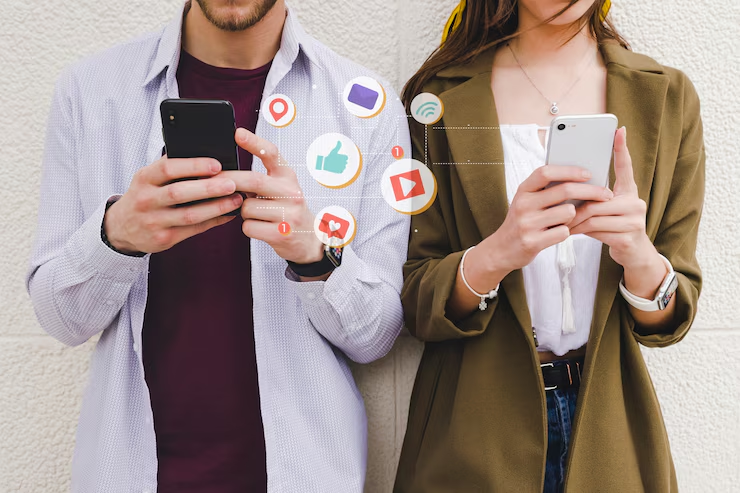People around the world use social media every day. Many check it the moment they wake up. Others scroll through their feeds while eating, working, or even before sleeping. Social media is no longer just a tool. It is a habit.
In the past, people spoke with friends face to face. Now, many prefer texting, sharing photos, or watching short videos. This has changed how people talk, share news, and spend time. Most do not even think about how often they use it. But this daily use is shaping the way people think and act.
Big apps like Facebook, Instagram, TikTok, and X (formerly Twitter) keep people online for hours. They show users posts based on their likes and clicks. This means each person sees something different, even if they follow the same topics. Over time, this changes how people feel and react to the world.
How social media affects thinking and emotions
Social media can change how people feel. It can make them happy, sad, jealous, or angry. When users see someone’s happy post, they may feel left out. If they see bad news again and again, they may feel stressed or afraid. These feelings can be strong, even if the post is not about them.
People often compare their lives to others. Social media shows only the best parts of someone’s life. This makes others feel like they are missing out. Some start to feel less happy with their own lives. Over time, this can lower self-esteem.
On the other hand, social media can make people feel connected. When someone likes a post or leaves a kind comment, it feels good. People can also find others who think like them. This can help build online communities. But sometimes these groups spread wrong information. Or they create anger between people with different ideas.
The rise of short attention spans

Most social media apps show short videos or quick posts. This keeps users interested but only for a few seconds. Over time, people get used to fast content. They want quick answers, short clips, and fast news. Long articles or deep talks feel boring to many.
This shift has changed how people learn and work. Many now skip reading full texts. They want quick headlines or short videos to understand topics. This also affects school and job focus. People now find it hard to sit still or focus for long.
Companies also change how they share news. They make posts short and easy to skim. They use big pictures, short text, and emojis. The goal is to keep people looking, even if just for a few seconds.
Changing how people talk and act
Social media has changed the way people speak. Many now use internet words, hashtags, or emoji in real life. Some even talk in memes. This is fun for many, but it also shortens how people talk.
In the past, people had long talks face to face. Now, many speak through short texts or voice notes. Real talks have become rare. Some even find face-to-face talks hard. This can lead to weaker social skills, especially in young people.
The way people act has also changed. Many do things just to post about it. For example, someone may visit a place only to take a photo. Or they may pretend to enjoy something just for likes. The goal becomes showing off, not enjoying the moment.
Online trends and challenges shape real actions
Each day, new online trends appear. Some are harmless, like dance videos or jokes. Others are risky, like dangerous stunts. Young users often follow these trends to fit in or get attention.
Many do not stop to think about the risks. They want likes, shares, or comments. This need for online praise pushes people to act in new ways. Some post private moments. Others join arguments online. Over time, these habits shape real behavior.
Even offline, people start to copy what they see online. They dress like popular users. They use the same slang. They even change their views to match people they follow. This shows how much power social media has on behavior.
Social media and the spread of fake news
Social media makes it easy to share news. But not all news is true. Some posts spread lies or wrong ideas. These can reach many people fast. Some believe what they read without checking. This is a big problem today.
Fake news can cause panic, fear, or hate. It can also change how people vote or act. Social media apps try to fix this. They add fact checks or warnings. But many still miss them or do not trust them.
Some people share fake news on purpose. Others do it by mistake. Either way, the result is the same. Wrong ideas spread fast. They shape how people think and what they believe.
How social media shapes self-worth
People often count their value by likes or followers. A post with many likes feels good. A post with no likes feels bad. This shapes how people see themselves.
Young people feel this more. They grow up with phones and apps. They want online praise. If they do not get it, they may feel sad or not good enough.
This can lead to stress, sleep loss, or even sadness. Some may change how they look just for likes. Others may stop posting at all. Social media shapes how people feel about themselves, even offline.
Privacy is harder to protect
When people share online, they often forget about privacy. Many post their location, daily life, or family. This information stays online. Others can save or share it.
Some apps also track user actions. They know what you like, watch, or search. This data helps show ads. But it also means someone always watches.
Many users do not read app rules. They press agree without looking. This gives apps the right to collect data. Later, people may feel shocked by how much was shared.
This change in behavior, sharing more and caring less, makes privacy harder. Once shared, it is hard to take back.
Social media and mental health
Many studies now show a link between social media and mental health. People who use social apps too much may feel lonely, sad, or stressed. They may sleep less, feel left out, or think they are not good enough.
This does not mean social media is always bad. It depends on how people use it. Talking to friends or learning something new can help. But if someone only watches others, it can hurt their mood.
Balance is key. Taking breaks or turning off apps helps. Spending time offline with real friends is also good for the mind.
Social media shapes opinions and ideas
What people see online affects what they believe. If someone sees the same idea many times, they may start to believe it, even if it is wrong.
Apps show posts based on likes. So, users often see the same type of post. This makes them think most people agree with them. This can create strong views and little room for other ideas.
People may stop listening to those who think differently. This can create online fights or hate. In real life, it can split friends or family.
To fix this, people need to check different sources. They also need to ask questions and not just believe what they see.
Work and business now depend on social media
Many people now work online. They sell items, share skills, or promote brands on social media. This has created new jobs, like content creators or brand managers.
Businesses also use social media to reach people. They post updates, answer questions, and build trust. They also use ads to target certain users.
But this also means more pressure. Workers feel they must always be online. They must post, reply, and create often. This can cause stress or burnout.
Still, for many, social media is part of work. It shapes how people sell, buy, and grow their jobs.
Conclusion
Social media has changed how people talk, think, feel, and live. It shapes behavior every day. Some of these changes help. Others hurt. But they all matter.
People must now ask: how much time is too much? How can we use social media without losing real life? These are big questions. And each person must find their own answers.
To stay safe, people need to think before they post. They should take breaks and spend more time offline. They should also ask questions and not believe everything they see.
Social media is not good or bad. It depends on how people use it. The more aware people are, the better choices they can make. And that starts by knowing how social media changes behavior.

